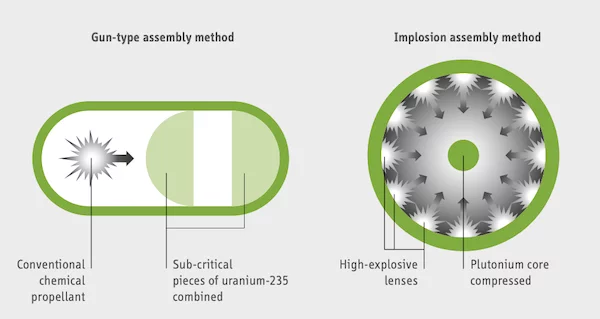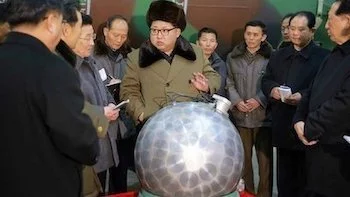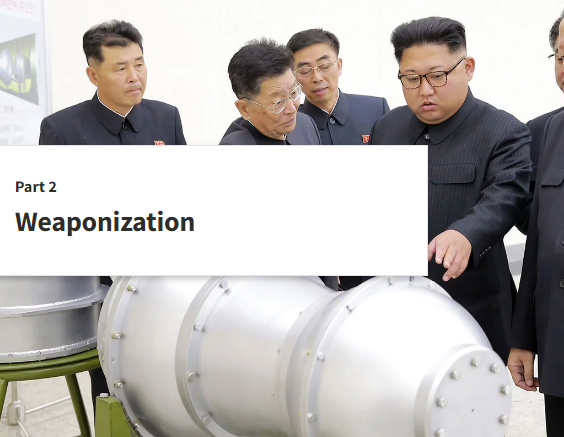Hinge Points: An Inside Look at North Korea’s Nuclear Program
Weaponization
The weaponization stage consists of the design, building, and testing of nuclear weapons. This stage requires an understanding of physics, not only nuclear physics, but also hydrodynamics, condensed matter physics, and many other aspects of physics under extreme conditions. It also requires chemistry, engineering, and materials expertise, such as for nuclear materials and high explosives. In addition, it requires manufacturing know-how and equipment, such as machining and welding. Most of these processes and operations are conducted in buildings and spaces that are undetectable by overhead satellite imagery. Nuclear testing requires an additional suite of mining and geological expertise along with electronics and diagnostics.
Fission bomb designs since the days of the Manhattan Project have been in one of two principal families of designs shown in Figure 2. The bomb detonated over Hiroshima was an HEU-fueled gun-assembly device. This design is technologically straightforward – two-subcritical masses of HEU are joined at high speed by a propellant in a gun barrel. The gun assembly method works only with HEU, as the design is not sufficiently rapid for plutonium. The second, the implosion device shown in Figure 2, uses powerful chemical explosives to rapidly compress a subcritical mass of either plutonium or HEU. Such a design fueled with plutonium was detonated over Nagasaki.

Figure 2. Two fission bomb designs. In the technically less sophisticated “gun-type” method used in the Hiroshima bomb (left), a subcritical projectile of HEU is propelled towards a subcritical target of HEU. This assembly process is too slow for plutonium. In the faster “implosion” method used in the Nagasaki bomb, plutonium is compressed beyond its normal metallic density to achieve a supercritical mass. The gun-type assembly works only with U-235, the implosion assembly works for either U-235 or Pu-239. (Eighth annual report of the International Panel on Fissile Materials, Global Fissile Material Report 2015: Nuclear Weapon and Fissile Material Stockpiles and Production, 2015 International Panel on Fissile Materials.)
In the early 1950s, both U.S. and Soviet scientists developed and tested hydrogen bombs based on the principle of compressing and fusing the hydrogen isotopes deuterium and tritium. Los Alamos scientists Edward Teller and Stanislav Ulam developed the breakthrough called radiation implosion for a hydrogen bomb. The concept was a two-stage thermonuclear bomb: using a fission bomb, called the primary, to compress the deuterium/tritium fusion fuel in the secondary by channeling the radiation from the primary to the secondary. Hydrogen bombs can be developed with virtually unlimited destructive power. The most powerful hydrogen bomb ever tested by the United States was Castle Bravo with a yield of 15 Megatons at Bikini Atoll in the Marshall Islands in March 1954. The Soviets detonated a 100 Megaton-class device, the Tsar Bomba, at an intentionally reduced half yield of 50 Megatons above the island of Novaya Zemlya in October 1961.
Nations keep the design and performance characteristics of their nuclear arsenal secret. However, North Korea has released teasers of its designs publicly through the Korea Central News Agency (KCNA). For example, in March 2016 it gave news media around the world access to photos of what it called its miniaturized nuclear weapon device (shown in Figure 3). In September 2017, it released photos of what it called a two-stage thermonuclear (hydrogen) bomb (shown in Figure 4). Not to leave anything to the imagination, some of the photos were taken in front of a diagram that shows how the warhead would fit into one of DPRK’s missiles. We, of course, do not know if these were the actual designs tested or ones that make up Pyongyang’s nuclear arsenal.

Figure 3. Kim Jong Un and Dr. Ri Hong Sop with purported nuclear fission bomb – March 2016 (KCNA).

Figure 4. Dr. Ri Hong Sop with Kim Jong Un and purported hydrogen warhead. In the background a diagram shows how the warhead would fit into one of DPRK’s missiles – Sept. 2017 (KCNA).
Nuclear test results as interpreted from the seismological signals they triggered provide some hints about North Korean nuclear designs. The estimated explosion yields of the six nuclear tests prior to 2022 are shown in Figure 5. During one of his visits, Hecker was told by North Korean nuclear officials that the first two used plutonium bomb fuel. The first test likely was below its design yield. The second appears to have been successful. The third could have been a plutonium or HEU device because by this time North Korea had uranium centrifuge capabilities. Based on comments made in the North Korean press, the test may well have been North Korea’s first HEU device. North Korea claimed that its fourth test was a hydrogen bomb, but it was more likely a “proof of principle” test of a hydrogen bomb because the explosion yield was too low for a hydrogen bomb. The fifth test is believed to be a miniaturized HEU device, perhaps like that shown in Figure 3. The sixth test in September 2017 was likely a hydrogen bomb due to its high explosion yield, although it is not possible to confirm that it was of the design shown in Figure 4, which Pyongyang claimed to be a two-stage thermonuclear (hydrogen) bomb.
| Test Date | Estimated Yield |
|---|---|
| October 9, 2006 | Close to 1 kiloton |
| May 25, 2009 | ~ 2 to 7 kilotons |
| February 12, 2013 | ~ 7 to 14 kilotons |
| January 6, 2016 | ~ 7 to 14 kilotons (Claim of hydrogen bomb likely false) |
| September 9, 2016 | ~ 15 to 25 kilotons (likely made progress in miniaturization |
| September 3, 2017 | >100 kilotons, possibly 250 kilotons (hydrogen bomb possible) |

